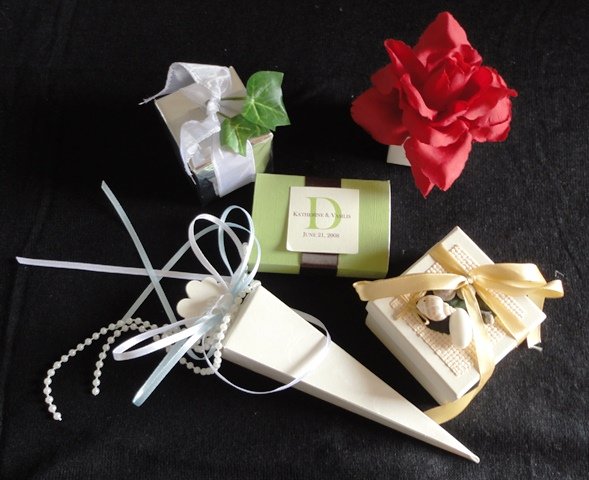Greek Wedding Favors
Georgia and her wedding boubouniera
Is it boubouniera? Or bomboniere? Perhaps bonboniere? What about boboniere? Or maybe bouboniera? Ah, yes also boubounniera. And not to be forgotten, bonbonniere. Having noted these various spellings, what can be said about this favor given as a gift to guests at weddings and baptisms? When spelled bomboniere—that’s Italian for box of sweets. The Italians claim it as their own. So do the French who spell it bonbonniere. And the Greeks claim it as well. Read on to learn about the place of the boubounniera in the Greek Orthodox wedding tradition.
The Sweetness and Bitterness of Marriage
Quoting from the wedding program of Georgia Nicon Madiba, donor of the Museum’s boubouniera collection: “At the reception each guest will receive a boubounniera/bonbonniere, traditional to both Greek and French weddings. The boubounniera/bonbonniere contains an odd number of white candied almonds called koufeta in Greek and dragees in French. The candies are said to symbolize the sweetness and bitterness of marriage. As they are eaten, the sweetness of the candy coating and the bitterness of the almond mingle and become inseparable. The odd number is indivisible just as Georgia and Pascal (her husband) will remain undivided.”
The boubouniera can vary from simple puffs of tulle tied with ribbon to much more elaborate pieces incorporating linen circles trimmed in lace or even embossed boxes or porcelain picture frames. The koufeta are traditionally white and usually number five or seven. It is said that a single woman will dream of her future husband if koufeta from a boubouniera are put under her pillow.
It is traditional to hold a koufeta wrapping party a few days before the wedding where the bride’s attendants and family gather to put the koufeta into their chosen containers. This event might be sponsored by the bride’s koumbara (maid or matron of honor).
Thanks to the donation of Georgia Nicon Madiba, the Museum now has a collection of over 60 examples of boubouniera primarily from weddings, with a few from baptisms. While most were favors at Greater Seattle area weddings, some were from sacraments in other parts of the United States and Greece.
Examples of Boubouniera
Here are a few examples of the traditional, basic style.
Basic boubouniera
Notice the colored netting and added touches in addition to ribbon.
Basic boubouniera with a flare
Fancier netting or lace handkerchiefs may be used.
Deluxe boubouniera
Boubouniera may be enclosed in a variety of boxes…
Boubouniera in boxes
..or in white or colorful fabric bags.
Boubouniera in bags
A guest might receive a useful item such as a glass, a small vase or a photo frame.
Boubouniera with props
A boubouniera might even closely resemble a corsage.
Boubouniera as corsages
At baptisms, toys may be attached as gifts.
Boubouniera for baptisms
ABOUT THE DONOR
All four of Georgia’s grandparents’ families came from Greece: Leros in the Dodecanese Islands, Avariko near Agrinion, and Sperchiada, and Kambia in Central Greece. Her parents were born in the United States. Hers was a mix of American and Greek cultures as she grew up. She developed her own interests in Greek dance, music, language and travel, eventually studying in Greece and becoming proficient in the language. Her boubouneria collection grew out of her childhood interest in crafts and the joy of receiving hand-crafted gifts of candy at weddings.
By Joann Nicon, January 2012
PHOTOS
Photos by John Nicon
SOURCES
Video interview by John and Joann Nicon, October 2011; Rouvelas, Marilyn. A Guide to Greek Traditions and Customs in America second edition. Bethesda, Maryland: Nea Attiki Press, 2002;
Blessed Celebration specializing in religious wedding and baptismal products
VIDEOS
Georgia Talks about her Collection
Georgia’s Greek Experiences










